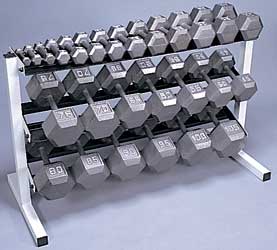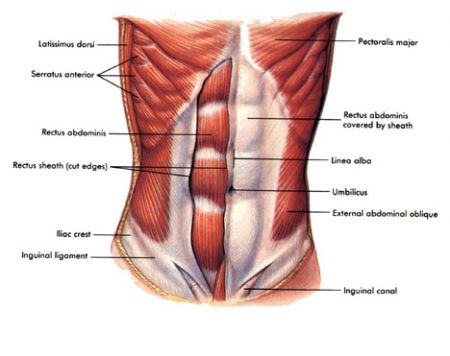
Being able to design good programmes is the one of the fundamental skills a personal trainer needs to be able to demonstrate. Our clients’ success depends on our skilful manipulation of the training variables and our financial success depends on our clients’ achieving their goals while hopefully enjoying the process. This all means we need to write exercise programs that are physically stimulating, mentally interesting, challenging and varied.
The object of this article is to explore the fundamentals of programme design with a view to sharpening up our programme design skills and avoiding getting stuck in a programme design rut!
The most common problem I see is that the majority of trainers write programmes that they would perform themselves…i.e. trainers with a cardiovascular background write CV programmes, whilst trainers with a resistance background invariably produce watered down hypertrophy sessions. This is not personal training! A clients’ programme should reflect their needs and wants and not reflect the area of interest of the trainer.
I recently heard about a personal trainer who had every single one of his clients on a very similar programme regardless of their experience, gender, goals or medical constraints…
1) 10 minute bike warm up
2) 20 minute treadmill intervals (1 minute fast/1 minute slow – 10 sets)
3) 2-3 resistance exercises (mainly isolation, performed as part of a split routine)
4) “Sit ups” – flexion based core movements (no extension, rotation, lateral flexion etc.)
5) Stretch (as time permits)
Example programme designed by a not – so personal trainer
Reps were always in the 8-12 range, 3 sets were performed each time and the last set was, almost without fail, performed as a drop set.
This kind of programme design is far removed from the personalized approach we teach at Solar Fitness Qualifications. The trainer in question (not one of our graduates!) may well experience some positive results with his clients initially but, needless to say, it won’t be long before his clients hit the dreaded “performance plateau” and a client who ceases to see improvements in their fitness and increases in their fitness levels is very likely to take their hard earned money elsewhere, leaving our not-so personal trainer with a gap in his diary and a subsequent drop in earnings – not a good scenario.
There are a number of prerequisite stages that need to be covered before we even set foot in the gym. Follow these steps and your clients will soon be well on their way to reaching their training goals…
STAGES OF PROGRAMME DESIGN
1) Gathering information
The first stage of programme design is to gather information. Initially, this should take the form of an in depth medical questionnaire, a discussion of the clients general lifestyle (nutrition, time available, exercise history, likes, dislikes etc) as well as goal setting.
2) Health screening
After establishing our clients’ goals etc, we need to screen our clients fully to ascertain their readiness to exercise. The normal battery of static tests should be applied – blood pressure, Resting Heart Rate, Lung Function and Body Composition. Remember these tests provide personal trainers with a legal safety net and should never be ignored. The results of these static tests may reveal underlying medical conditions and also provide an opportunity for medical referral.
3) Fitness Testing
Once we have established that our client is healthy enough to commence exercising, it may be necessary to conduct some rudimentary fitness testing including appropriate tests for cardiovascular fitness, muscular strength and endurance, flexibility and proprioception/balance. This information can then be used to establish musculoskeletal fitness, energy system fitness, the setting of initial intensity levels and monitoring improvements in the coming months.
4) Review
On completion of this initial consultation, it might be necessary to adjust our clients’ goals if the gathered results suggest that they are unrealistic. Remember it is much better to under promise but then over deliver rather than over promise and under deliver! More often than not it is the trainer who will be blamed for the client not reaching their fitness goals, and not the client for non-compliance so ensure goals are challenging but realistic targets to improve your chances of success.
5) Personalised programme design
When we have gathered all the pertinent information, it’s time to put pen to paper and start being creative with our programme design.
The first rule of programme design is “treat what you find”. Fitness training IS therapy and we have gained a lot of information about our clients physical well being. The results of our testing should be the lynch pin on which our programme is based…
If the client is weak then they need to develop strength
Client is unfit then cardiovascular exercise needs to be prescribed
Poor flexibility? Developmental stretching is required
Poor posture? Postural correction exercises are needed
Weak core? Poor muscular endurance?
Poor proprioception? You get the idea!
Treating what you find is the very essence of personal training – an individualized approach based on the clients physical needs.
Not every client wants to be a bodybuilder!
Something I have noticed many trainers often do, regardless of their clients’ needs, wants or goals, is to prescribe split routines. Split routines are the reserve of the body builder or strength athlete and really have no place in the average gym users’ weekly schedule!
The whole point of a split routine is to permit large amounts of volume to be performed for individualized muscle groups to encourage hypertrophy to occur which is influenced directly by training volume. Very few of our clients are seeking such a specialized response from their exercise routines and therefore are most of them aren’t candidates for this type of training.
The majority of our clients will benefit far more from performing different whole body routines 2-3 times weekly plus an appropriate amount of cardiovascular exercise on the days in between.
Full body training uses large amounts of energy, eliminates the need for lots of isolation exercises, is extremely time efficient, promotes muscular balance and trains the body as a single synergistic unit – which is how it normally functions. All it takes is a single missed workout from a weekly split routine and the whole programme becomes unbalanced whereas missing one day of whole body training will, other than a missed exercise opportunity, will still address all of the clients’ muscular needs. Also, human nature being what it is, it’s quite likely that if a client is going to miss a workout, it’s going to be one they enjoy less or find hardest and chances are, that’s the one they can’t afford to miss because it’s the one that addresses their weaknesses.
Whole body training requires creativity on behalf of the trainer, intelligent planning, correct ordering of exercises and also belief from the trainer that whole body training is a viable and useful method of training and not for “beginners only”. Writing split routines is relatively easy as it allows for a “kitchen sink” approach to exercise selection – no need to select quality exercises based on merit or functionality when you can do them all in a single session!
When teaching programme design I use the following template to help my students learn how to correctly order their exercises. This template does the hard work for you by balancing movement patterns and avoiding overlapping muscle groups.
1) Compound leg exercise e.g. squats
2) Horizontal pushing exercise e.g. bench press
3) Horizontal pulling exercise e.g. bent over rows
4) 2nd leg exercise (preferably also compound) e.g. lunges
5) Vertical pushing exercise e.g. shoulder press
6) Vertical pulling exercise e.g. lat pull downs
7) Triceps exercise e.g. tricep push down
8) Biceps exercise e.g. bicep curls
9) 1st core exercise e.g. stability ball crunches
10) 2nd core exercise e.g. 45 degree back extensions
By slotting exercises into the above template, the trainer can easily produce an effective and well balanced whole body routine. With regard to repetitions and sets, these values are goal and fitness level dependent but somewhere between 8-20 reps for 1-4 sets should meet the majority of exercisers needs. Begin with a conservative approach to intensity and volume with the view of making the workout more intense over time as the client becomes fitter and more able to perform the workout. Remember that you don’t have to use the same rep and set scheme for all the exercises. Distribute the volume of the workout as necessary. For example you may have the client perform 3 sets of the leg exercises but only 2 sets for the rest of the body and only 1 set for the arms at the end.
Making progress
Once the basic programme has been designed and has been followed for a period of time, it will become necessary to manipulate the training variables to promote further improvements in fitness…
The training variables include the following:
Altering the rep range
Decreasing the rest periods
Increasing the number of sets being performed
Changing the exercises e.g. from machine to free weight
Increasing number of exercises per muscle group
Increasing the load being used
Altering the order of the exercises
Progressing exercise complexity/skill requirement
Increasing the balance or stability demand of the exercise e.g. progressing to stability ball exercises
Using unilateral (single limbed) movements
Combining exercises into complexes, supersets or adopting other training systems e.g. drop sets, super slow, pre exhaust or post exhaust training to name a few.
Periodic manipulation of the training variables and rotation of exercises should result in an almost endless variety of workouts without having to resort to split routines which are best left to bodybuilder wannabes and aren’t really suited for the majority of our typical clientele. There is nothing wrong with split routines per se, just the fact that they are often prescribed to clients’ whose requirements would be better met by whole body programmes.












